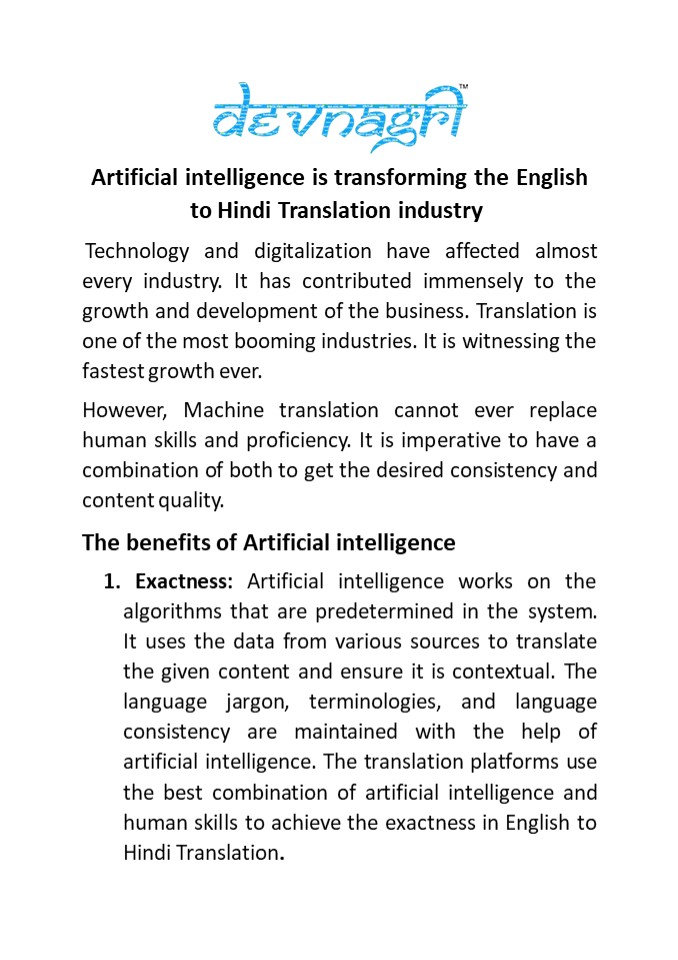Artificial intelligence is transforming the English to Hindi Translation industry - PowerPoint PPT Presentation
Title:
Artificial intelligence is transforming the English to Hindi Translation industry
Description:
Artificial intelligence tools and English to Hindi translation systems are a boon. They not only translate content but polish it too. These systems make it possible for translation agency to trans-create volumes of content with ultimate precision. The human translators perform various quality control checks using the artificial intelligence enable system and tools.Visit - – PowerPoint PPT presentation
Number of Views:97
Title: Artificial intelligence is transforming the English to Hindi Translation industry
1
Artificial intelligence is transforming the
English to Hindi Translation industry Technology
and digitalization have affected almost every
industry. It has contributed immensely to the
growth and development of the business.
Translation is one of the most booming
industries. It is witnessing the fastest growth
ever. However, Machine translation cannot ever
replace human skills and proficiency. It is
imperative to have a combination of both to get
the desired consistency and content quality. The
benefits of Artificial intelligence 1. Exactness
Artificial intelligence works on the algorithms
that are predetermined in the system. It uses
the data from various sources to translate the
given content and ensure it is contextual. The
language jargon, terminologies, and language
consistency are maintained with the help of
artificial intelligence. The translation
platforms use the best combination of artificial
intelligence and human skills to achieve the
exactness in English to Hindi Translation.
2
2. Fast turnaround time The English to
Hindi Translation can be a complex and
time-consuming process. The manual translation
and proofreading may take hours and days to
complete a given task, Moreover, the chances to
miss the terminologies and language consistency
are also high in the case of only manual
translation. Artificial intelligence checks
content on various parameters. It provides
accurate information concerning the clarity,
engagement level, and language consistency of the
content. Apart from this, Artificial
intelligence also
reduces proofreading time. It
content delivery process whilst
escalates the enhancing the
- quality of the content.
- Formatting and styling The contemporary tools in
artificial intelligence enable software and
systems to be tailor-made to suit the varied
needs of the translation solution provider. The
formatting and placement of the text in the
content can be managed efficiently with these
systems. Artificial intelligence reduces styling
errors and can quickly format translated content
as per the requirement. - Technology Translation technology used by
- artificial intelligence is a neural machine
translation. The NMT analyses the pattern of
language based on the various documents and
3
contents from varied sources to translate from
English to Hindi. The NMT provides a superior
level of precision and accuracy. Artificial
intelligence provides support to translators.
The constant feedback and suggestion from the
system enable one to refine the content and flag
up issues related to tonality, linguistic
references, terminologies, jargon, etc. 5.
Cost-effective Artificial intelligence tools
and English to Hindi translation systems are a
boon. They not only translate content but polish
it too. These systems make it possible for
translation agency to trans-create volumes of
content with ultimate precision. The human
translators perform various quality control
checks using the artificial intelligence enable
system and tools. The key takeaway Artificial
intelligence is having a positive impact on the
translation industry. It is contributing
significantly by utilizing technology to the
fullest and the positive aspects of human
translation. Artificial intelligence and modern
translation tools are contributing immensely to
its success and accuracy. Artificial
intelligence- enabled translation systems can
maintain the quality of the content and
eliminate the probability of errors too.































